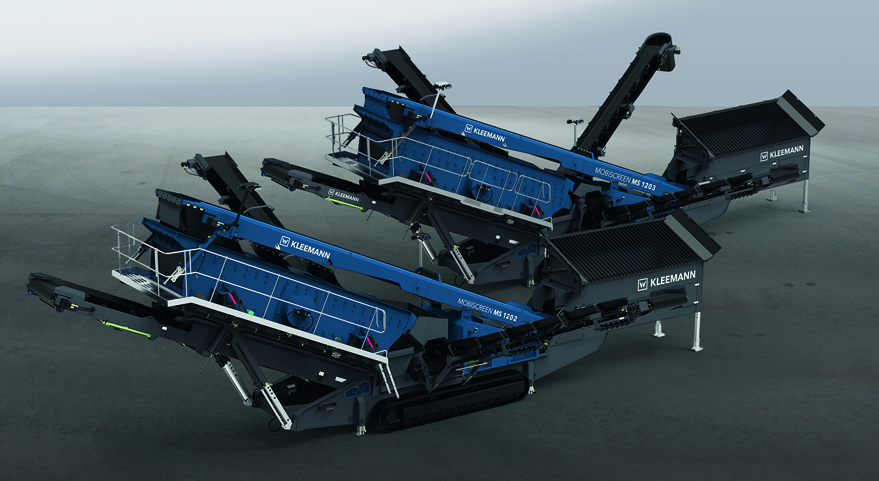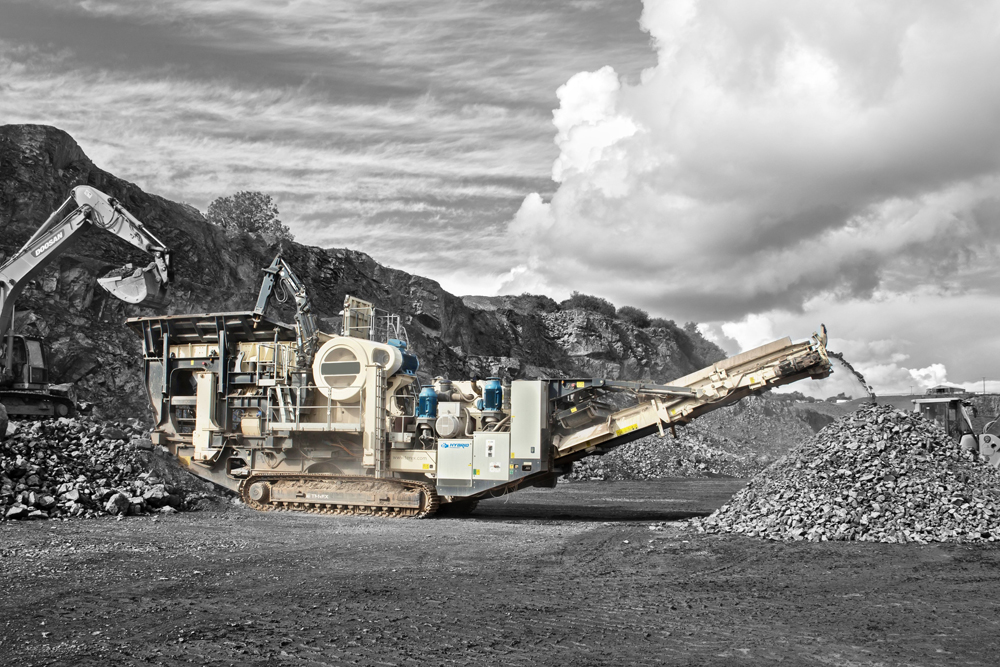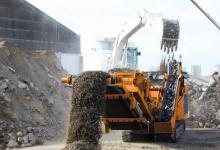Crushers can be used to crush a huge selection of materials thanks to their wide range of applications, from recycling to crushing natural stone. Often the crusher is fed with a high proportion of fine material, which needlessly passes through the crushing process, increasing wear and energy consumption while reducing throughput.
As a remedy, a bar mesh is normally used for pre-screening. However, if the fine material is damp and cohesive, it can quickly clog up the mesh screen and ends up passing through the crusher anyway. Austria-based RUBBLE MASTER (RM) says this is the reason it has launched the patented RM Active Grid, a new pre-screen that is claimed to increase material throughput by up to 30% and reduce wear.
Construction and demolition (C&D) waste, concrete rubble, asphalt, wall gravel and river gravel are just a few examples where a high proportion of fine particles can be found in the feed material. If a pre-screening system is not used, all the material ends up in the crusher, irrespective of particle size, often passing through the whole crushing process.
RM says that, unfortunately, the fine material causes unnecessary wear to the hammers, impact plates and wear plates in the crushing box, as well as higher energy consumption in the form of diesel or electricity because the rotor is subjected to higher stress. The result is higher running costs because the hammers and wear plates need to be replaced more frequently, and maintenance cycles are shorter. This not only reduces the efficiency of the crusher, but also reduces profit, because material throughput is lower, but running costs are higher.
For this reason, in many cases a bar mesh is used for pre-screening the fine material and small particles. So far so good, says RM, except that the bar mesh has the disadvantage that due to its rigid construction it clogs up over time, especially with damp, sticky or loamy, cohesive material, reducing its pre-screening efficiency. Even with dry material, the screening rate is often not ideal. This again causes most of the material to enter the crushing box, or block the inlet to the crushing box, slowing down the flow of material. This has the effect of reducing the crusher throughput, increasing wear and requiring the crusher to stop so that the bar mesh can be cleaned.
RUBBLE MASTER says it developed the RM Active Grid to solve these problems. It consists of rigid and movable sections of bar mesh that feature a special configuration. The vibration of the vibro-channel causes the Active Grid to oscillate, so it does not need its own drive system. The active vibration of one section of the bar mesh significantly increases the screening performance and, depending on the material and the type of job, increases the total material throughput by up to 30%. Efficiency is also increased thanks to the self-cleaning effect of the Active Grid, ensuring consistent screening performance. The fine material can then bypass the crushing box onto the main discharge belt, or be discharged on a side discharge belt.

The result is claimed to be more material throughput, less wear, lower costs and longer maintenance intervals, which ultimately adds up to more productivity and profitability. If pre-screening is not required because the crusher is being used for a different application, the RM Active Grid can also be fitted with a subfloor, which is quickly installed.
The RM Active Grid is available for RM 100GO! and RM 120X crushers.
Because processing requirements vary greatly from one job to another, RUBBLE MASTER naturally offers a range of solutions for pre-screening. In addition to the RM Active Grid and a standard bar mesh, a 2-deck pre-screen integrated into the feed belt is also offered for defined feed material particle sizes. RM also offers the HS series of mobile pre-screens, which is available in a range of sizes.
Terex Finlay has launched the LJ-130 hybrid jaw crusher, the largest mobile jaw crusher in its range which has been developed for large-scale quarry and mining operations. The machine can operate as a standalone primary crusher or integrated into a mobile or static crushing and screening plant.
The machine incorporates a Terex 1300 x 1000mm (51” x 39”) high-performance electrically driven single toggle jaw chamber. The large chamber inlet opening has been engineered to accept the coarsest feed, including large boulders in the feed material, and the chamber cavity depth of 2.3m (7’ 5”) provides high reduction ratios and maintains an efficient material flow through the plant.
For ease of transportation the machine has been engineered with a compact operational footprint and can be split down into two transportable components without the need for heavy crane assistance on site for setting up, tearing down and transporting between locations.
The machine features a 13.5m³ (17.64yd³) hopper with an integrated pan feeder and heavy-duty VGF feeder, with automatic power monitoring to regulate and automatically increase or decrease material flow to prevent overload and ensure continuous choke feeding of the jaw chamber for optimum and uninterrupted productivity.
The machine can be powered either by the integrated 500kVA genset powerpack configuration or connected to an external power source. Both power options provide operators with significant power, servicing and maintenance cost savings in direct comparison to a diesel/hydraulic-powered plant.
“The LJ-130 hybrid jaw crusher has been developed to provide a robust and powerful mobile solution for operators seeking a highly productive machine for the most demanding and coarsest hard rock and ore applications,” said Alan Witherow, Terex Finlay product manager.
“The Terex 5139 crusher is the largest jaw chamber we put on our tracked plants in terms of depth, width and length. The large cavity volume enables more material to be processed along the full length of the chamber, maximising productivity even with the coarsest unprepared material at the primary crushing stage. The LJ-130 jaw crusher is perfectly complemented by our existing C-1554 cone crusher and large capacity screens such as our 984 horizontal and 696 inclined screeners models for operators looking for large capacity mobile crushing and screening train solutions.”
Key features of the LJ-130, including the plant’s electrically driven power systems, provide significant cost advantages and environmental efficiencies.
The large feed width and gape enables the crusher to accept larger and coarser material reducing the need for hammering of oversized product in the virgin feed material.

Automatic variable speed VGF ensures continuous choke feeding of the crushing chamber for optimal productivity.
High-powered electric drive ensures precise chamber controls and reverse functionality for clearing blockages and assisting in construction demolition, asphalt and recycling applications.
For ease of commissioning and transportation the machine can be dismantled into two separate components without the need for cranes.
T-Link telematics hardware and software along with free seven-year data subscription are fitted and installed as standard.
Germany-based Kleemann is offering two new mobile classifying screens with a feed capacity of up to 750 t/h that the Wirtgen-owned company says guarantee effective screening of large volumes.
The MOBISCREEN MS 1202 and MS 1203 are available with two or three screen decks and have screening surface areas of 12m² in the upper and middle deck and 11m² in the lower deck. They thus make hourly outputs of up to 750 tonnes possible.
Aiko Fischer, product manager for screening plants at Kleemann, said: “To achieve these high outputs, the material flow must be well designed. Kleemann has thus generously dimensioned the feed hopper with a holding volume of 10m³. This makes feeding both with a crushing plant as well as with a large wheel loader possible. Despite discontinuous feeding by the wheeled loader, the large hopper volume ensures continuous material supply to the screen. Correspondingly wide feeding and discharge conveyors guarantee an unobstructed material flow over the screen. The high-torque diesel engine also ensures that the plant does not ‘run out of steam’.”
Both screens can be combined with both the crushing plants from the Kleemann EVO series and the PRO series.










